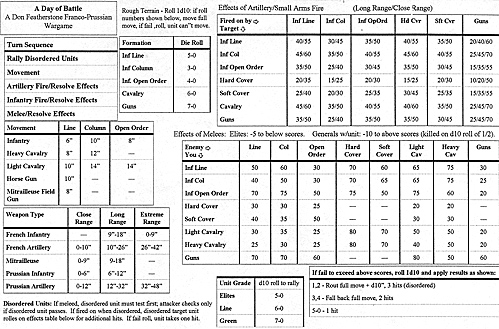 The rules presented here originated from two articles in MWAN, and are based on Don Featherstone's morale based game published in his book on the Peninsula War. Figure scale is 1:60, though any figure basing or scale system can be utilised. Now back to Brad
The rules presented here originated from two articles in MWAN, and are based on Don Featherstone's morale based game published in his book on the Peninsula War. Figure scale is 1:60, though any figure basing or scale system can be utilised. Now back to Brad
They play quickly and easily, and are an elegant little game system. No more time consuming morale rolls, or adding up factors. Just look it up on the table and roll for it. We are pretty much converting all of our gaming to this system. Any period can use it - just come up with the proper categories and fill out your tables. We recently played a game with each of us having 16 or so units (infantry battalions, cavalry regiments and artillery batteries) in about 2 to 2.5 hours. Try that with some of the other rules systems. If you like seeing your figures die by the handful, you probably won't care for these rules. However, if you want to be a GENERAL, seeing the 'big picture', try these - you may like them.
A quick background to the rules. Each unit has either 4, 5, or 6 hits that it can accumulate before being removed from the table. Elite units have 6 hit boxes, Line units have 5, and Green units have 4 boxes. When all the boxes are crossed out, remove the unit from the table. Before the game starts, add up all the hit boxes of your army and divide by two. When that many boxes have been lost in total, your army must retreat, having decided that they have had enough (giving your opponent the victory).
When firing or meleeing, you don't roll for your units effect on its opponent. Your opponent rolls and tries to roll higher than the values shown on the table. If he fails then that unit will have to mark off the appropriate number of hit boxes. The rules are fairly 'free kriegspiel' -- If you find something not 'covered, just make it up as you go.
There are no modifiers on flank or rear attacks. I handle them as follows: enfilade fire on a line, fire effect is as firing on a column. Enflade fire on a skirmish line, fire effect is as firing on a line. Flank or rear attacks in melee are handled by not allowing the flanked unit to fire on the attacker as he comes into contact. This ensures that a flanking unit will at least come into contact and fight the flanked unit. A full frontal attack presents no guarantees that you will survive to make contact.
Units in melee can be seen to flail away at each other until one unit is forced to retire from the combat before continuing to the next turn. This simulates close range freights as much as any actual crossing of bayonets.
Instead of a modifier being used to represent the General's Influence, the presence of a General allows a unit to re-roll a bad roll. This second roll stands regardless of result. Regardless of the second die result, the General's player must roll again - if he rolls 1,2, or 3, the General is dead. I like to think of it as the general having to make himself (or his staff) more visible and inspirational when dealing with poor quality troops. After all, if your own troops can now see you more readily, so can the fellows shooting at you!
The Unit Die
What is a 'unit die' ? A unit die is a differing size die that reflects the relative qualities of green, average and elite troops. Green troops have an 8 sided die, average troops 10, and veterans 12. This eliminates the need for troop grade modifiers. Now you simply find the value on the chart and beat it using the appropriate unit die for your unit troop class. Now it's much more tense the first time you glibly announce that you are using your General to aid a green class unit and then remember that you have to roll better than a 1, 2, or 3 on on eight sided die.
Obviously an elite unit is much more likely to shake off anything 'bad' that has happened to it as compared to a unit of quaking, green farm boys who have to roll an eight sided die on the 'Critical Event' effects tables.

Jumbo Charts very slow: 295K
Previously published in MWAN, by kind permission of Hal Thinglum
Back to The Gauntlet No. 1 Table of Contents
Back to The Gauntlet List of Issues
Back to Master Magazine List
© Copyright 1994 by Craig Martelle Publications
This article appears in MagWeb (Magazine Web) on the Internet World Wide Web.
Other articles from military history and related magazines are available at http://www.magweb.com